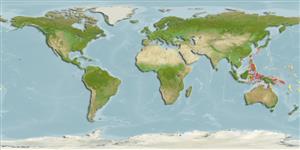Classification / Names
Common names from other countries
Main reference
Size / Weight / Age
Max length : 7.0 cm SL male/unsexed; (Ref. 9962); 5.5 cm SL (female)
Environment
Marine; demersal; depth range 0 - 1 m (Ref. 90102)
Climate / Range
Tropical, preferred ?
Distribution
Western Pacific: Hsiao-liu-chiu Island, off southwestern Taiwan; south to Kur Island, Indonesia.
Countries | FAO areas | Ecosystems | Occurrences | Introductions
Short description
Dorsal
spines
(total): 12 - 14;
Dorsal
soft rays
(total): 19-21;
Anal
spines: 2;
Anal
soft rays: 21 - 23. Dorsal fin XII-XIV, 19-21; membrane between spinous and segmented-ray portions notched deeper than half length of first segmented ray; membrane from posteriormost ray beginning from between dorsal edge of caudal peduncle at caudal-fin base (rarely) to dorsal edge of caudal fin up to 18% caudal-fin length in specimens ? 3 cm SL; anal fin II, 21-23 (23 only in males); pectoral-fin rays 13-14; vertebrae 10+27 to 30 = 37 to 40 (rarely 40); lacking nape cirrus; orbital cirrus simple, rarely a single branch or a few short, fine filaments at tip, typically shorter than orbital diameter; nasal cirrus simple, relatively long (typically half orbital diameter); lateral line canal continuous anterodorsally with simple pores (no vertical pairs), extending posteriorly to between verticals from bases of 6th and 9th dorsal-fin spines (usually to between verticals from 7th and 8th spines), then continuing posteriorly and posteroventrally as series of 1-6 (rarely 1 or 6) short, disconnected, horizontally bi-pored canals/tubes in skin; posteriormost tube area below and between verticals from bases of 7th spine and second segmented dorsal-fin ray (rarely posterior to vertical from 12th spine); mandibular pores 3-5; lacking posterior canines; ventral margin of upper lip and dorsal margin of lower lip entire; both sexes from ?3 cm SL with well-developed, fleshy, blade-like crest on dorsal part of head; crest of females comparatively smaller than males’; spinous portion of dorsal fin dusky, crossed by several diagonal, paler-dusky stripes with dark margins; segmented ray portion faint dusky with numerous dark pinstripes coursing length of fin, stripes coalescing into reticular pattern posteriorly. Male max. size ca 7 cm SL; female max. size ca 5.5 cm.
IUCN Red List Status (Ref. 115185)
Threat to humans
Harmless
Human uses
More information
ReferencesAquacultureAquaculture profileStrainsGeneticsAllele frequenciesHeritabilityDiseasesProcessingMass conversion
Tools
Special reports
Download XML
Internet sources
Estimates of some properties based on models
Phylogenetic diversity index
PD50 = 0.5001 many relatives (e.g. carps) 0.5 - 2.0 few relatives (e.g. lungfishes)
Trophic Level
2.0 ±0.00 se; Based on food items.
Resilience
High, minimum population doubling time less than 15 months (Preliminary K or Fecundity.)
Vulnerability
Low vulnerability (17 of 100)
Price category
